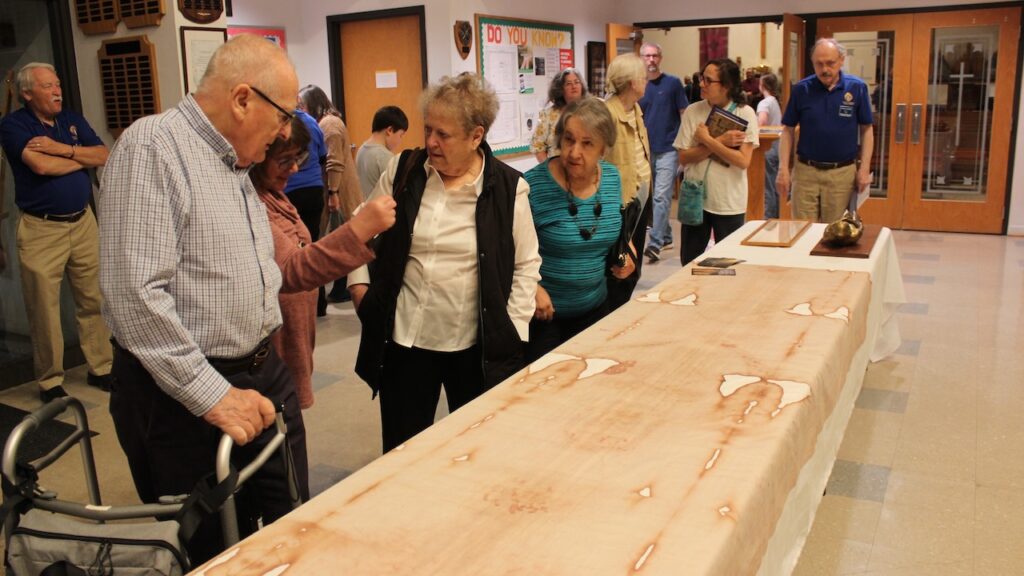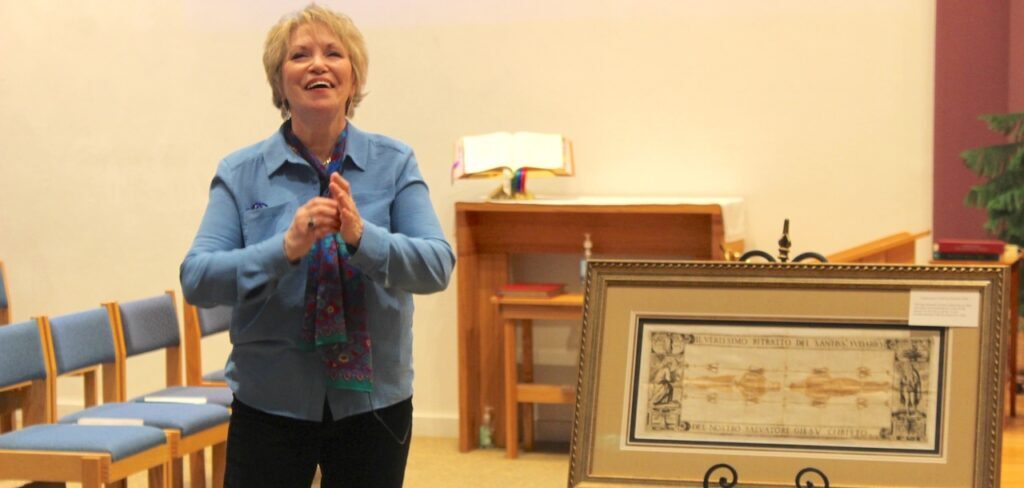Lenten missions often feature prayer, guest speakers and Scripture reflections. At Christ the King, Abingdon, March 28-29, a two-night mission also included some forensic science, medieval history and quantum physics.
According to the presenter, history professor Cheryl White, researchers in those fields and other disciplines have furthered the case for the authenticity of the Shroud of Turin and deepened the mystery of what she calls “the single most studied artifact in the world.”
More than 100 people each night came to hear White, a scholar at Louisiana State University Shreveport, discuss the controversies that surround the purported burial cloth of Christ. They also viewed pieces from a collection of art showing the display and veneration of the shroud over hundreds of years.
“What I hope people take away from this is an encounter with the person of Jesus Christ,” said Father Chris Masla, pastor of Christ the King and St. John the Evangelist, Marion.
“As we reflect on his Passion, amplified in the image of the shroud, my hope is that we are truly able to receive the good news in our hearts that Christ suffered for us,” said Father Masla.
Among the exhibits White displayed was a full-size replica of the shroud: a high-resolution digital image imprinted on a cotton cloth the same length and width as the original. She said it had just been sent to her the previous week and the Abingdon group was among the first to see it.

“This is a man who bears all the wounds that are consistent with the Gospel accounts,” she said. “He has been scourged. He has been crucified. He has been capped with something thorny on his head, and he has a piercing wound right between the fifth and sixth ribs on the right side that has oozed both blood and clear fluid from that wound.”
Belief in the Shroud of Turin is not required for Catholics. The Church does not have a position on the shroud’s authenticity, but allows for the study and veneration of it.
Experts determined years ago that the image of that crucified man is not made from paint, pigments or dyes. Pictures of the shroud taken in the 1890s and again in the 1930s create a photographic positive, meaning that the image itself is a negative, resting on just a few tiny fibers of the linen at the same depth across the cloth.
As people gazed at the replica, others peered at the paintings and etchings displayed in the church nave and narthex. They belong to the Richard Orareo Collection, co-curated by White, which includes five centuries of artifacts related to the history of the shroud.
On the table with the cotton replica was a model of Christ as he probably lay before the burial linen was draped over his body.
“The spatial relationship between the places where the shroud touched the body and the places that it did not is exactly perfect across the linen,” she said. “It means that this shroud covered a human form when the image was created.”
Images taken with a device that can turn a flat photograph into a three-dimensional image have also revealed how the body was positioned inside the linen cloth.

A devout Catholic, White has devoted her academic career to studying the Shroud of Turin, delving into Vatican archives for journal articles and books. She is currently working to trace some of the missing history of the shroud, including during the 13th and 14th centuries.
She currently serves on the board of directors of the Shroud of Turin Education and Research Association. She has been featured in documentaries on the History Channel and EWTN and was consulted on the Shroud of Turin exhibit at the Museum of the Bible in Washington, D.C. She gave talks at World Youth Day 2023 in Portugal and the 10th National Eucharistic Congress last year in Indianapolis. She often comes to Abingdon to visit a son who works at the Barter Theater.
As White outlined the history and science behind this famous artifact, she also drew her audience to the Scripture passages that it foreshadows and reflects. The image of the thorns pressed into the man’s head, she said, recalls the banishment of Adam and Eve from the garden in Genesis 3, in which God tells them that they will now have to eat wild plants and that the ground will grow weeds and thorns.
As White reminded the group, light was the first thing God created. Jesus described himself as the Light of the World. The light the apostles saw at the transfiguration was different from any light they had seen before. And theoretical physics, she said, suggests that a transformation involving light too powerful to create and too short to measure could have created the image on the shroud.
“Because the body in the shroud retained all of its form but none of its mass, because the body is now pure light, there is nothing in the physical world that will impede the cloth from falling straight through the body along the plane of gravity,” she said, creating that perfect match of front to back, but without any lateral view.
Brian Potter, a Christ the King parishioner, said he’s been interested in the Shroud of Turin for several years. “All the evidence [indicated] that it was of supernatural origin, that it was the burial shroud of Jesus, so that’s incredibly fascinating,” he said.
Valerie Ponce found the talks fascinating. “It just makes me want to go learn more about it,” she said. “But also, there’s that point where you can’t know anymore. Science can only explain so much.”
Eva Kling found joy in hearing about the pollen and stone dust that point to the Middle Eastern origin and travels of the cloth. “You can only go so far with it before you have to rely on – do you believe it or do you not?” she said.
Dawn Smith said she found the speaker and the information compelling. “When you see those images, it just kind of gives you goosebumps,” she said.

